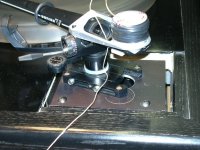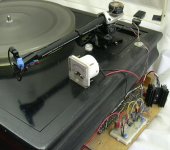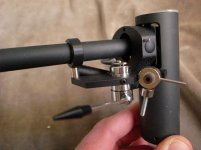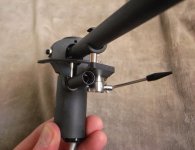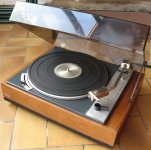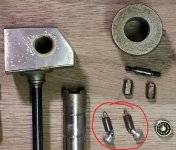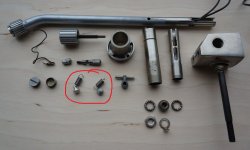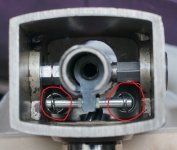I've just written an short essay with an archive of photos, movies & more information here:-
Voyd Reference Io Ltd. no counterweight SME V - Google Drive
Please feedback any thoughts and questions? Enjoy!
Summary
Springs: In the early 1990s I was asked by Audio Innovations (now Audio Note UK) to design a new tone arm that employed a spring instead of a counterweight called 'Delta Inertia'. I designed and constructed dozens of prototypes with many hundreds of hours of experimenting / listening tests, then set up a production run of around 120 all sold via retail dealerships. Everyone thought a sprung tone arm yielded significantly better sound reproduction c/w a counterweighted tone arm, especially in the bass and dynamic contrast.
Magnets: In 2003 I built a version that replaced the spring with two permanent magnets in opposition. Magnets it turned out enabled better record warp riding ability, and far more stability bouncing around on spring sub chassis turntables than tone arms with springs or counterweights could.
Prior Art: In 1978 Lewis Eckhart was granted US patent 4,114,895 on a tone arm using both spring and (pseudo) magnetic levitation. I first saw it July 2021 researching this essay. Eckhart aimed to reduce inertial mass to better track record warps by replacing the counterweight and stem it rides on with a leaf spring of same length. A permanent magnet is attached at the spring's far end. And a curved bar magnet is fixed underneath.
Post Art: In 2009 GB patent 2459273A was granted to Eric Vant on another tone arm with no counterweight, claiming “Superior audio reproduction is possible due to the improvements in stylus trace accuracy and a more constant tracking force”. It employs (pseudo) magnetic levitation, and like all such tonearms, upwards arm movement whilst riding a warp increases the gap between magnets, thereby they “dynamically increase the effective mass (weight) of the tone arm cartridge” to better track warps.
Vant's (pseudo) magnetic levitation assembly is mounted at 90 degrees facing upwards, directly above the gimbal bearing pivot planes. This is done to minimise changes in the direction of gravity on the tonearm's geometry / mass whilst it tracks inevitable record warps, thereby minimising oscillations in its moment of inertia. Vant claims this is an improvement on Eckhart's spring / magnet, and indeed on all counterweighted tonearms.
Attachments
Mmm.. lots of interesting stuff - need time to assimilate.
I understand the argument for eliminating the counterweight to reduce effective mass, but the marketplace has moved the other way. It looks like you are sensing stylus position and using it as a feedback signal for setting VTF via the electromagnet. Are you additionally using this feedback signal for some type of active damping control? Several Japanese tonearms have been marketed with this feature. Active feedback for tonearm damping control was explored by the 3M company who published a paper in the Vol 3, #26 of the AES Journal in 1975, and were granted a US patent 1976. 3M, however, used a semiconductor cartridge and derived the feedback signal directly from the cartridge output.
1975 AES Journal
AES E-Library >> Overcoming Record Warps and Low-Frequency Turntable Rumble in Phonographs
1976 Patent
US4102536A - Phonograph pickup device
- Google Patents
Ray K
I understand the argument for eliminating the counterweight to reduce effective mass, but the marketplace has moved the other way. It looks like you are sensing stylus position and using it as a feedback signal for setting VTF via the electromagnet. Are you additionally using this feedback signal for some type of active damping control? Several Japanese tonearms have been marketed with this feature. Active feedback for tonearm damping control was explored by the 3M company who published a paper in the Vol 3, #26 of the AES Journal in 1975, and were granted a US patent 1976. 3M, however, used a semiconductor cartridge and derived the feedback signal directly from the cartridge output.
1975 AES Journal
AES E-Library >> Overcoming Record Warps and Low-Frequency Turntable Rumble in Phonographs
1976 Patent
US4102536A - Phonograph pickup device
- Google Patents
Ray K
Just by giving the counterweight some freedom to move from back to forth and reverse it's enough to counteract the inertial mass effect at vertical movement.I saw a guy on youtube presenting such a tonearm, then i remembered Jiri Janda's flat tonearm with a liquid oscillating counterweight so i copied the idea instantly and you can measure significant differences in tonearm effective weight at the stylus tip in every single position on the vertical axis.Associating this with a flabby tonearm gives a possible resonant behaviour a hard time.A spring counterweight looks like a more elegant solution as it works in every direction, but maybe a rubber used instead of a steel spring might be a bit better.
Last edited:
Here are my thoughts.
Firstly effective mass is not the mass at the stylus tip, it is a product of the moment of inertia and is the force required to commence upwards or sideways movement.
Moment of inertial calculations are quite simple I=md^2, where I = moment of inertia, m = mass and d = distance from the pivot, ^2 is squared.
So with a regular CW it's relatively easy to calculate I. A spring will complicate this as well as the possibility of vibrating.
Good tonearms have NO erroneous movement, take a look at the SAT youtube video where they set bearing preload, this arm shows little to no vertical movement as a product of sideways movement, it's very stable.
Now look at the engineering that it entails. Huge arm wand and bearing housing lead filled CW very close to the pivot, the stylus tip and horizontal pivot are lined up down the center of the arm wand and the COG central to the arm wand. Now calculate "I" through the COG to form an ellipse and move this forward, the stylus tip is central to the vertical ellipse and slightly below the horizontal, hence we have a very stable platform to hold the cartridge.
To take this a little further look at most offset headshell straight tonearms and the stylus tip is slightly to the left of the center of the arm wand, this offset causes a torque around the center of the wand so vertical movement will also cause horizontal movement. Now lower the COG with a low slung CW and you also have a pendulum, Look at the Schroder CB arm youtube video very unstable vertical movement, it's a pendulum.
My point here is addressing these issues will give far greater improvement as it follows the laws of physics than experimenting magnetic/spring with CW's.
Firstly effective mass is not the mass at the stylus tip, it is a product of the moment of inertia and is the force required to commence upwards or sideways movement.
Moment of inertial calculations are quite simple I=md^2, where I = moment of inertia, m = mass and d = distance from the pivot, ^2 is squared.
So with a regular CW it's relatively easy to calculate I. A spring will complicate this as well as the possibility of vibrating.
Good tonearms have NO erroneous movement, take a look at the SAT youtube video where they set bearing preload, this arm shows little to no vertical movement as a product of sideways movement, it's very stable.
Now look at the engineering that it entails. Huge arm wand and bearing housing lead filled CW very close to the pivot, the stylus tip and horizontal pivot are lined up down the center of the arm wand and the COG central to the arm wand. Now calculate "I" through the COG to form an ellipse and move this forward, the stylus tip is central to the vertical ellipse and slightly below the horizontal, hence we have a very stable platform to hold the cartridge.
To take this a little further look at most offset headshell straight tonearms and the stylus tip is slightly to the left of the center of the arm wand, this offset causes a torque around the center of the wand so vertical movement will also cause horizontal movement. Now lower the COG with a low slung CW and you also have a pendulum, Look at the Schroder CB arm youtube video very unstable vertical movement, it's a pendulum.
My point here is addressing these issues will give far greater improvement as it follows the laws of physics than experimenting magnetic/spring with CW's.
@warrjon
"Here are my thoughts.
Firstly effective mass is not the mass at the stylus tip, it is a product of the moment of inertia and is the force required to commence upwards or sideways movement."
You need to measure the effect this mass at the stylus tip, it's where it matter the most...and it looks like your SAT guy sais the same thing:
Swedish Analog Technologies SAT Tonearm, High End Munich - YouTube
I avoid looking at Munich presentations of all sorts of ultraexpensive exotic arms that tell nothing about arm design and speak more about audiophile fashion and 24k gold plating technique...
"Here are my thoughts.
Firstly effective mass is not the mass at the stylus tip, it is a product of the moment of inertia and is the force required to commence upwards or sideways movement."
You need to measure the effect this mass at the stylus tip, it's where it matter the most...and it looks like your SAT guy sais the same thing:
Swedish Analog Technologies SAT Tonearm, High End Munich - YouTube
I avoid looking at Munich presentations of all sorts of ultraexpensive exotic arms that tell nothing about arm design and speak more about audiophile fashion and 24k gold plating technique...
Last edited:
Why do people pick on one thing
I just missed adding
Firstly effective mass is not the mass at the stylus tip, it is a product of the moment of inertia and is the force required to commence upwards or sideways movement at the stylus tip.
This is the video I was refering to
Swedish Analog Technologies - SAT tonearm bearing pre-load - YouTube
I just missed adding
Firstly effective mass is not the mass at the stylus tip, it is a product of the moment of inertia and is the force required to commence upwards or sideways movement at the stylus tip.
This is the video I was refering to
Swedish Analog Technologies - SAT tonearm bearing pre-load - YouTube
Last edited:
Mmm.. lots of interesting stuff - need time to assimilate.
I understand the argument for eliminating the counterweight to reduce effective mass, but the marketplace has moved the other way. It looks like you are sensing stylus position and using it as a feedback signal for setting VTF via the electromagnet.
Are you additionally using this feedback signal for some type of active damping control? Several Japanese tonearms have been marketed with this feature. Active feedback for tonearm damping control was explored by the 3M company who published a paper in the Vol 3, #26 of the AES Journal in 1975, and were granted a US patent 1976. 3M, however, used a semiconductor cartridge and derived the feedback signal directly from the cartridge output.
Ray K
Thanks Ray,
1. 'Effective mass' as such is more than just moments of inertia. The 'real mass' as manifest in mechanical impedance at the cartridge reference pivot point is INCREASED by removing c/weight as I describe in my essay.
2. The "market place" for vinyl & replay in practice barely exists: any perception it may have "moved" seems a bit hopeful at best ;-) !
3. I did build an "active damping control" but observed / heard no improvements to warp riding or sound quality c/w passive (pseudo) magnetic levitation which far exceeds any other tone arm design on its own - see videos here
Voyd Reference Io Ltd. no counterweight SME V - Google Drive
4. I thought about deriving the feedback signal directly from the cartridge output, but analogue control signal processing was too difficult (and uninteresting) for me to (bother to) achieve. Plus its all too easy to screw up low output moving coil cartridge audio signal with phase problems clouding any potential improvements. Besides 3M were aiming to sell something at a price and show off how clever they are, I didn't have those constraints ;-) For example, their AES (paywalled) article acknowledges they needed a custom cartridge that could provide cleaner sub 20Hz warp signals than standard carts, which have low frequency cut off built in on purpose, to control already high IM distortions inherent.
I have a conceptual problem with magnetic or spring replacement of the counterweight: the stylus tracking force should be constant, independent from the upwards/downwards movement of the cartridge due to record warp. But this force is linearly changing with the displacement in case of a spring, and follows a second power law in case of magntic repelling force.
Here's an old Lenco tonearm that uses a spring instead of a counterweight:
Record changers made by The Voice-of-Music and other manufacturers that were used in old stereo consoles typically used springs and no counterweight.
Ray K
I can't see any springs on the Lenco L 70 tone arm...?
https://c2.staticflickr.com/6/5327/8810586000_60c4936d3e_b.jpg
https://www.lencoheaven.net/forum/index.php?topic=6709.0
I guess The Voice-of-Music etc use of springs was usability / portability / warp riding as a bonus / set and forget rather than sound quality in and of itself.
I have a conceptual problem with magnetic or spring replacement of the counterweight: the stylus tracking force should be constant, independent from the upwards/downwards movement of the cartridge due to record warp. But this force is linearly changing with the displacement in case of a spring, and follows a second power law in case of magntic repelling force.
The point is that counterweights & pivots & moments of inertia oscillate at warp frequencies, hence 'effective mass' manipulations to tune the frequency - whereas square law magnets a) damp those oscillations, and b) largely eliminate them being able to occur at all by removing the counterweight - as can be seen the videos demonstrations I uploaded to this link:
Voyd Reference Io Ltd. no counterweight SME V - Google Drive
gravitational force follows a second power law with respect to distance too... while real life springs diameter is decreasing with elongation making it stiffer by the time they get longer...
This is correct, however, as I note in my essay - at the scale of turntables and humans - gravity is in effect a linear law.
Attachments
Thanks yes, I see them now! But I also see a knurled metal component sticking out the back where a counterweight normally is. Hence I conclude perhaps those rather small springs are part of a fine tracking weight adjustment mechanism rather than a complete counterweight replacement?
Surely the Sony Biotracer did this better 40 odd years ago?
Hi Bill, The Biotracer had a counterweight as well as advanced sensor / damping tech. What do you mean by saying it "did this better"?
Classic Hi-Fi: Sony PS-X600
- Home
- Source & Line
- Analogue Source
- Tone arm improvements - no counter-weight (pseudo) magnetic levitation
